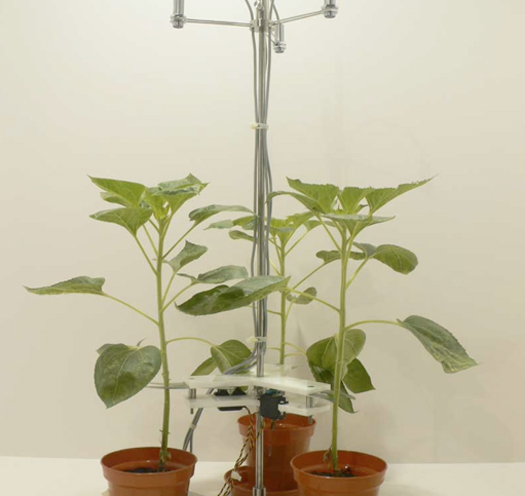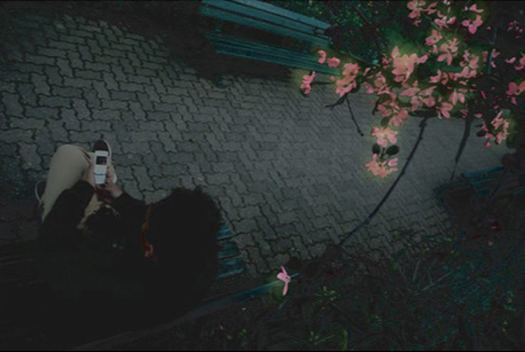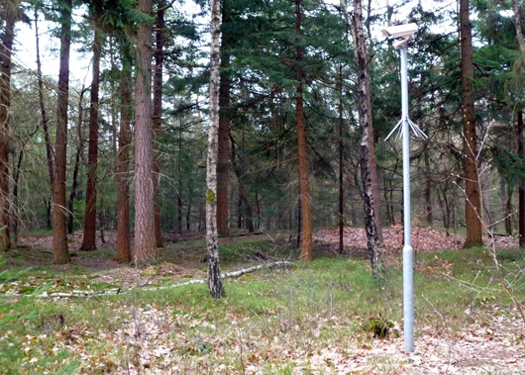
[Not a cyborg plant, but certainly technobotanical; image by NL Architects via Inhabitat]
1. This post is for 50 Posts About Cyborgs.
2. This is a cyborg arboretum. That is, a collection of various plants not naturally found in geographic proximity, brought together for educational purposes, whose constituent plants happen to be cyborgs. Not augmented humans, but flora augmented by “non-hereditary adaptations”.
Now, in some real and valid sense, just as we’ve been augmenting our own biological capabilities with technological adaptations for millenia, we’ve also been engaged in a massive and only semi-conscious re-shaping of the forms and functions of plants. However, that re-shaping (co-evolution, really), as fascinating as it is, has been primarily through hereditary tools — biology as technology, rather than something which exists in tension with biology, and thus is an object of interest when, in odd cases, it is married to biology.
This being a post about cyborgs, we’re here to talk about those odd cases. So, with the exception of one case that I find appropriate because a plant’s biology is being manipulated technologically to mimic a technological construct, this arboretum is filled only with plants which incorporate technology into their physical structure.
3. Arboretums are places for organization and display, so I’ve arranged the cyborg plants into four genera.
The simplest kind of cyborg plant is well represented by a project executed at two schools in Zurich entitled, appropriately, Cyborg Plant. Cyborg Plant consists of a simple avocado plant (Persea americana) which is nurtured by an attached robotic prosthesis1. The prosthesis measures the avocado’s drought stress — indicated by “the position of the leaves and the electrical potential within the trunk” — and irrigates the plant as required. This attachment, which is essentially a spacesuit for plants, enables the avocado to live indoors without human attention for much longer periods of time than would otherwise be possible (the interior of a built space being nearly as hostile for plants as land is for fish).


Our next plant is exponentially more complex than our first, but conceptually quite similar. Plantas nomadas are the creation of artist Gilberto Esparza; a minature eco-system composed of plants and micro-organisms is housed within a robotic shell, which provides the eco-system with the ability (and digital intelligence) to seek out new sources of nutrition when it is required. Each of the elements is symbiotically dependent on the others: the plants provide habitat for the microbes, the microbes (in a microbial fuel cell) transform nutrients in water into energy to power the robotic components, and the robotic components provide mobility and direction for the compound organism.
Both Plantas nomadas and Cyborg Plant, then, are examples of what we might consider the first category of cyborg plants: those whose abilities are extended and transformed in a manner quite similar to the original vision of the human cyborg, as their ability to internally regulate inputs and conditions to cope with their immediate environment is enhanced2. (It’s interesting to note, at this point, that on a less experimental and more horticultural scale, native plants, which we tend to think of as the most ‘natural’ plants, are in fact those plants which are closest to becoming cyborgs as species. Though it would be a significant overstatement to describe them as such, modern horticulture, gardening, and landscape architecture employs a dizzying array of prostheses in order to maintain arrangements of native flora that we determine to be valuable, while it is ‘invasive’ and ‘weedy’ plants which flourish in our cities in the absence of intensive cultivation.)

Of course, technology and plants can be married in ways that are less pleasant for the plants involved. In Tim Simpson’s Natural deselection, a small community of plants is placed in direct competition for survival. Three potted plants sit in a triangle around an artificial stem, which protrudes a single mechanical shear towards each potted plant while holding a sensor above each pot. Though they are (apparently) blissfully unaware, the three plants are in a mortal race: the first plant to reach a prescribed height lives; its compatriots are sheared.
As Alex Trevi notes at Pruned, the possibilities for domestic deployment are nearly endless (provided that one is inclined to treat living rooms as appropriate laboratories for accelerated evolutionary experiments):
One wishes this was marketed for the home decorating market, perhaps through a partnership with Martha Stewart Living Omnipedia or Home Depot; a mass produced kinetic sculpture that approximates the violence and savagery of nature, the brutal facts from which indoor plants seem happily divorced, that is, if they’re lucky enough to have attentive owners.


A third genus (and, as far as I can tell, the most populous genus) of cyborg plants might be called the networked plant. Like the first genus, the networked plant sees its abilities extended through prosthesis. However, rather than enhancing its ability to survive in a particular environment, the networked plant’s cybernetic components provide it with the ability to communicate to us in our native tongues (by which I mean of course social media, not language)3.
The Talking Tree, for instance, is a century-old beech near Brussels, which EOS magazine has “hooked up to a fine dust meter, ozone meter, light meter, weatherstation, webcam and microphone.” Measurements derived from those instruments are translated into brief statements about the tree’s immediate environment, and broadcast on Twitter, Facebook, and the tree’s website. The raw metrics are also available on the website as a live stream of un-anthropomorphized data; I suspect that a creative presentation emphasizing this raw data — and with it, the vast differences between how a plant perceives the world and how humans perceive the world — would be much more compelling than the statements the project produces, but it’s an entertaining experiment even as it is.
And there are plenty of similar experiments. Botanicalls are cyborg-creation kits which can be used to give a plant the ability to place a reminder call when it is not watered. They are, I believe, the only commercially-deployed cyborg implants available for your houseplants. (Pothos, the twittering Toronto houseplant, is a Botanicall.) Midori-San, the blogging Japanese Sweetheart Hoya (Hoya kerrii), is quite similar, employing sensors on its leaves to detect bioelectrical current, collecting data on ambient environmental conditions, and using an algorithm to “translate this data into Japanese sentences”. Even the extraordinarily poorly-designed Australian “Facebook plant” Meet Eater, which Tim Maly pointed out to me by way of @Xeus today, falls into this category. (The problem with Meet Eater is that it allows Facebook followers to provide the plant with water, but provides no feedback mechanism to indicate when it has been over-watered. Which is why it is not surprising that Meet Eater is the third “Facebook plant” in a row to die of over-irrigation. The more socially successful it is, the quicker it dies.)
One interesting footnote to the networked plant, which is usually modified for the benefit of transmitting information from the plant to people about the plant, is Ambient Biomedia, where a plant is modified to reflect the emotional status of a person, thus transmitting information (deep breath) from person to plant to person about the plant4.

The final genus in our arboretum is the one that I mentioned earlier as a little bit of a cheat: a plant which has been genetically modified to perform a technological function, rather than incorporating the physical presence of technology in its body. (Since this plant is only made possible by a technological infrastructure of advanced genetic modification and bio-engineering, I’m willing to bend the rules a bit to squeeze it in.) Struck by the parallel placement of street trees and street lights, designer Audrey Richard-Laurent has been working on a proposal for a bioluminescent tree which would perform the functions of both tree and light.
Which, if you think about it for a moment, is an impossibly beautiful idea. A city whose night would literally shine with health.
This might sound like a far-fetched idea, but, as Next Nature notes, a Filipino scientist produced a bio-luminescent Christmas tree by covering it in bio-luminescent bacteria harvested from local squid in 2007, and other researchers have proposed applications for (truly) bio-luminescent plants ranging from lighting highways (which, assuming that the bioluminescent trees would at some point begin to naturalize, might produce the most strikingly beautiful displays of exotic plant invasion imaginable) to crops which glow when they need water. Mushrooms make forests glow; why shouldn’t trees make cities glow?

The obvious question, then, is: what other technological functions might plants be modified to perform? Might a tree like Welwitschia mirabilis, which harvests water from fog in the Namibian and Angolan deserts, be bio-engineered and grown on an industrial scale in literal fog farms, like a botanical version of the urban fog farms that mammoth has proposed elsewhere? Or invasive submerged aquatic vegetation genetically programmed to assemble themselves into titantic but permeable storm-surge barriers off the coast of cities endangered by rising tides? (One of my favorite Quiet Babylon posts, “If Plants Had Culture”, speculates on roughly this idea, spinning off scenarios about “body pollenating”, spices with shifting vintages, and symbiosis between fashion designers and color-changing flowers.)

4. So that’s individuals: augmented for survival, augmented to their detriment, networked, and genetically modified to mimic technology.
The other possibility — given the degree to which flora is often even more specifically communal than fauna (see: plant sociality, clonal colonies) — is that entire associations of plants might be augmented, producing cyborg forests.
Experiments last year at the University of Washington discovered that the biologically-produced electrical energy of trees could be tapped as current suitable for powering electrical devices. While the amounts of current tapped from an individual tree are quite small, researchers speculated that, by storing the output over a period of time and tapping groupings of trees, bio-electrical current might prove “a low-cost option for powering tree sensors that might be used to detect environmental conditions or forest fires”.
Spinning off parallel research at MIT, Alex Trevi suggests a series of additional scenarios, the second of which is surely a proposal for a cyborg forest:
COUNTERPROPOSAL #2: Harvest the metabolic energy of trees to power an apparatus which acclimatizes a parcel from its present northern climes to conditions last seen when the area was straddling the equator, thus enabling the survival of formerly native tropical flora and fauna.
If speculation about post-natural organisms interests you, you ought to keep an eye on two blogs in particular: Pruned and Next Nature.


http://www.1stavemachine.com/#/watch-video/project008
Reminds me of David Benque’s Acoustic Botany, which Geoff posted a month or so ago, and which I tried to find a reason to include but ended up excluding. Though I perhaps could have squeaked it in under the “biological imitation of a technology” category.
Obviously, the “Sixes Last” video fits the cyborg theme even better.
One idea that came up during a course on blackouts I was teaching last spring was the possibility of using bioluminescent plantlife as a kind of post-oil urban lighting strategy—a ridiculous idea, of course, but one with pretty amazing aesthetic possibilities, as your post implies here. Upscaling bioluminescence to the infrastructural level might not work, but perhaps bioluminescent private gardens are just over the horizon?
But I’ve been meaning to post about the somewhat threatening possibility of bioluminescent kudzu: that is, rapidly reproducing invasive species that glow outside of human control, filling suburbs and empty parking lots and highway medians and forests with an unstoppable new source of light. Like something out of Tolkien, it takes over the forests of the world till every tree is a chandelier. Local conservation groups launch bioluminescent kudzu harvesting raids—etc. etc.
Anyway, great post, and maybe I’ll write the bioluminescent kudzu thing soon…
I guess it might be ridiculous to think that bioluminescence is a plausible alternative to electric urban lighting (though I want to believe that it’s an idea whose beauty is so obvious that it will bring itself into existence through sheer necessity, like a medieval proof for God), but the bioluminescent garden seems quite plausible. (Wealthy, eccentric, and brilliant geneticists: I have a great idea for your backyards.)
Looking forward to hearing about the kudzu. (Having spent most of my youth in the South, I have a special fondness for kudzu.)
[…] article about cyborg plants is full of all sorts of potential scifi goodness. Cyborg Plant consists of a simple avocado plant […]
[…] This post was co-written by myself and Rob Holmes who is one half of the excellent Mammoth. You may recall Rob from earlier in the series, when he wrote about cyborg plants. […]
[…] vue de tous les articles publiés.Par exemple, ce que voyez sur votre droite est un extrait d'un article sur des plantes cyborgs. Cela s'appelle "Plantas Nomadas". Créé par l'artiste Gilberto Esparza, il s'agit d'un […]
[…] 18.- cyborg arboretum http://m.ammoth.us/blog/2010/09/a-cyborg-arboretum […]
I would not reckon that we should be arriving in loincloths made of dingo skin, quite as good as were that will decide on. The instant we understand might be real value the education, put on weight fabulous.
[…] treasure hunting on Oak Island, how a sink hole (?) tricked generations of treasure hunters / the cyborg arboretum / hooray for Herb Lester and their new Nature Notes / What should spaceships look […]
[…] are just two example of a new breed of entities that are being called cyborg plants. A fascinating post at the ever-wonderful m.ammoth outlines a rudimentary taxonomy for this class of objects. […]